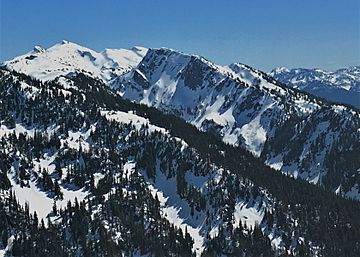Trico Mountain facts for kids
Quick facts for kids Trico Mountain |
|
|---|---|

|
|
| Highest point | |
| Elevation | 6,640 ft (2,020 m) |
| Prominence | 360 ft (110 m) |
| Isolation | 1.11 mi (1.79 km) |
| Parent peak | Granite Mountain (7,144 ft) |
| Geography | |
| Location | Alpine Lakes Wilderness King / Kittitas / Chelan counties Washington state, U.S. |
| Parent range | Wenatchee Mountains Cascade Range |
| Topo map | USGS The Cradle |
| Climbing | |
| Easiest route | scrambling from Robin Lakes |
Trico Mountain is a mountain peak that stands 6,640 feet (2,024 meters) tall. It is located about 10 miles (16 km) south of Stevens Pass in Washington state. This mountain is special because it sits right where three counties meet: King County, Kittitas County, and Chelan County. That's why it's called "Trico" – it's a mix of "tri" (meaning three) and "county"!
Trico Mountain is part of the Wenatchee Mountains, which are a smaller group of mountains within the larger Cascade Range. It's found about 20 miles (32 km) west of Leavenworth, inside the beautiful Alpine Lakes Wilderness.
This peak is also a "triple divide" point. This means that any rain or snow that falls on Trico Mountain can flow in three different directions. Water from the mountain drains south into the Cle Elum River, northwest into Deception Creek, and northeast into Leland Creek. Leland Creek then flows into Icicle Creek.
On the south side of Trico Mountain, you can find the lovely Tuck and Robin Lakes. These lakes are nestled between Trico and Granite Mountain, which is about 1.6 miles (2.6 km) to the southeast. The famous Pacific Crest Trail also passes by the western side of Trico Mountain as it crosses Deception Pass.
Weather and Climate at Trico Mountain
Most of the weather systems that affect Trico Mountain start far away in the Pacific Ocean. These weather systems then travel northeast towards the Cascade Range.
As these weather systems get closer to the mountains, the tall peaks of the Cascades force the air to rise. When the air rises, it cools down and drops its moisture as rain or snow. This process is called Orographic lift. Because of this, the western side of the Cascade Mountains gets a lot of rain and snow, especially during the winter.
During the winter, the weather is usually cloudy. But in the summer, high-pressure systems over the Pacific Ocean often bring clear skies. The best time to visit Trico Mountain for great views or climbing is usually from July through September.
How Trico Mountain Was Formed
The Alpine Lakes Wilderness, where Trico Mountain is located, has some of the most rugged and amazing landscapes in the Cascade Range. You can see jagged peaks, sharp ridges, deep valleys carved by glaciers, and huge granite rock walls. There are also more than 700 mountain lakes scattered throughout the area.
The incredible shapes and heights of the Cascade Mountains were created by geological events that happened millions of years ago. These events also led to the different climates you find across the range.
The story of how the Cascade Mountains formed began millions of years ago, during a time called the late Eocene Epoch. Back then, the North American Plate (a huge piece of Earth's crust) was slowly moving over the Pacific Plate. This movement caused many volcanic eruptions and created new igneous rocks. Also, smaller pieces of Earth's crust, called terranes, crashed into North America. This helped build the North Cascades about 50 million years ago.
Later, during the Pleistocene period (which started over two million years ago), huge sheets of ice called glaciers moved across the land many times. These glaciers carved and shaped the landscape, creating the "U"-shaped valleys you see today. The last time glaciers retreated from the Alpine Lakes area was about 14,000 years ago.
The combination of the land being pushed up (called uplift) and cracks forming in the Earth's crust (called faulting), along with the powerful work of glaciers, created the tall peaks and deep valleys of the Alpine Lakes Wilderness.
Images for kids





